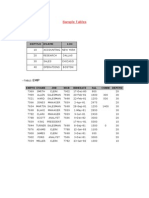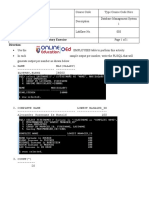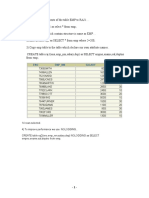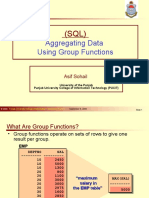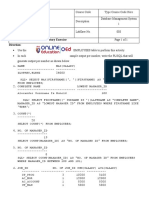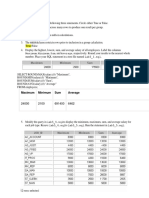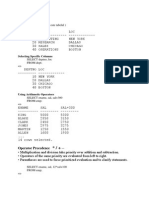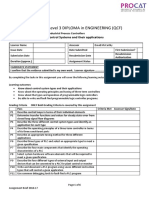0 ratings0% found this document useful (0 votes)
4 views5 Aggregating Data
5 Aggregating Data
Uploaded by
PaulThe document discusses SQL group functions which operate on sets of rows to provide aggregate results. It describes various group functions such as COUNT, AVG, SUM, MIN, MAX and how to use the GROUP BY and HAVING clauses to group data and filter groups.
Copyright:
© All Rights Reserved
Available Formats
Download as PDF, TXT or read online from Scribd
5 Aggregating Data
5 Aggregating Data
Uploaded by
Paul0 ratings0% found this document useful (0 votes)
4 views21 pagesThe document discusses SQL group functions which operate on sets of rows to provide aggregate results. It describes various group functions such as COUNT, AVG, SUM, MIN, MAX and how to use the GROUP BY and HAVING clauses to group data and filter groups.
Copyright
© © All Rights Reserved
Available Formats
PDF, TXT or read online from Scribd
Share this document
Did you find this document useful?
Is this content inappropriate?
The document discusses SQL group functions which operate on sets of rows to provide aggregate results. It describes various group functions such as COUNT, AVG, SUM, MIN, MAX and how to use the GROUP BY and HAVING clauses to group data and filter groups.
Copyright:
© All Rights Reserved
Available Formats
Download as PDF, TXT or read online from Scribd
Download as pdf or txt
0 ratings0% found this document useful (0 votes)
4 views21 pages5 Aggregating Data
5 Aggregating Data
Uploaded by
PaulThe document discusses SQL group functions which operate on sets of rows to provide aggregate results. It describes various group functions such as COUNT, AVG, SUM, MIN, MAX and how to use the GROUP BY and HAVING clauses to group data and filter groups.
Copyright:
© All Rights Reserved
Available Formats
Download as PDF, TXT or read online from Scribd
Download as pdf or txt
You are on page 1of 21
5
Aggregating Data
Using Group Functions
Copyright Oracle Corporation, 1998. All rights reserved.
Objectives
After completing this lesson, you should
be able to do the following:
• Identify the available group functions
• Describe the use of group functions
• Group data using the GROUP BY clause
• Include or exclude grouped rows by
using the HAVING clause
5-2 Copyright Oracle Corporation, 1998. All rights reserved.
What Are Group Functions?
Group functions operate on sets of rows to give
one result per group.
EMP
DEPTNO SAL
--------- ---------
10 2450
10 5000
10 1300
20 800
20 1100
20 3000 “maximum MAX(SAL)
20 3000 salary in ---------
20 2975 the EMP table” 5000
30 1600
30 2850
30 1250
30 950
30 1500
30 1250
5-3 Copyright Oracle Corporation, 1998. All rights reserved.
Using AVG and SUM Functions
You can use AVG and SUM for numeric data.
SQL> SELECT AVG(sal), MAX(sal),
2 MIN(sal), SUM(sal)
3 FROM emp
4 WHERE job LIKE 'SALES%';
AVG(SAL) MAX(SAL) MIN(SAL) SUM(SAL)
-------- --------- --------- ---------
1400 1600 1250 5600
5-6 Copyright Oracle Corporation, 1998. All rights reserved.
Using MIN and MAX Functions
You can use MIN and MAX for any datatype.
SQL> SELECT MIN(hiredate), MAX(hiredate)
2 FROM emp;
MIN(HIRED MAX(HIRED
--------- ---------
17-DEC-80 12-JAN-83
5-7 Copyright Oracle Corporation, 1998. All rights reserved.
Using the COUNT Function
COUNT(*) returns the number of rows in a
table.
SQL> SELECT COUNT(*)
2 FROM emp
3 WHERE deptno = 30;
COUNT(*)
---------
6
5-8 Copyright Oracle Corporation, 1998. All rights reserved.
Using the COUNT Function
COUNT(expr) returns the number of
nonnull rows.
SQL> SELECT COUNT(comm)
2 FROM emp
3 WHERE deptno = 30;
COUNT(COMM)
-----------
4
5-9 Copyright Oracle Corporation, 1998. All rights reserved.
Group Functions and Null Values
Group functions ignore null values in the
column.
SQL> SELECT AVG(comm)
2 FROM emp;
AVG(COMM)
---------
550
5-10 Copyright Oracle Corporation, 1998. All rights reserved.
Using the NVL Function
with Group Functions
The NVL function forces group functions
to include null values.
SQL> SELECT AVG(NVL(comm,0))
2 FROM emp;
AVG(NVL(COMM,0))
----------------
157.14286
5-11 Copyright Oracle Corporation, 1998. All rights reserved.
Creating Groups of Data
EMP
DEPTNO SAL
--------- ---------
10 2450
10 5000 2916.6667
10 1300
20 800 “average DEPTNO AVG(SAL)
20 1100 salary ------- ---------
20 3000 2175 in EMP
10 2916.6667
20 3000 table
20 2975 for each 20 2175
30 1600 department” 30 1566.6667
30 2850
30 1250 1566.6667
30 950
30 1500
30 1250
5-12 Copyright Oracle Corporation, 1998. All rights reserved.
Creating Groups of Data:
GROUP BY Clause
SELECT column, group_function(column)
FROM table
[WHERE condition]
[GROUP BY group_by_expression]
[ORDER BY column];
Divide rows in a table into smaller groups
by using the GROUP BY clause.
5-13 Copyright Oracle Corporation, 1998. All rights reserved.
Using the GROUP BY Clause
All columns in the SELECT list that are not
in group functions must be in the GROUP
BY clause.
SQL> SELECT deptno, AVG(sal)
2 FROM emp
3 GROUP BY deptno;
DEPTNO AVG(SAL)
--------- ---------
10 2916.6667
20 2175
30 1566.6667
5-14 Copyright Oracle Corporation, 1998. All rights reserved.
Using the GROUP BY Clause
The GROUP BY column does not have to
be in the SELECT list.
SQL> SELECT AVG(sal)
2 FROM emp
3 GROUP BY deptno;
AVG(SAL)
---------
2916.6667
2175
1566.6667
5-15 Copyright Oracle Corporation, 1998. All rights reserved.
Grouping by More
EMP
Than One Column
DEPTNO JOB SAL
--------- --------- ---------
10 MANAGER 2450
DEPTNO JOB SUM(SAL)
10 PRESIDENT 5000
-------- --------- ---------
10 CLERK 1300
10 CLERK 1300
20 CLERK 800 “sum salaries in 10 MANAGER 2450
20 CLERK 1100 the EMP table 10 PRESIDENT 5000
20 ANALYST 3000 for each job,
20 ANALYST 6000
20 ANALYST 3000 grouped by
20 CLERK 1900
20 MANAGER 2975 department”
20 MANAGER 2975
30 SALESMAN 1600
30 CLERK 950
30 MANAGER 2850
30 MANAGER 2850
30 SALESMAN 1250
30 SALESMAN 5600
30 CLERK 950
30 SALESMAN 1500
30 SALESMAN 1250
5-16 Copyright Oracle Corporation, 1998. All rights reserved.
Using the GROUP BY Clause
on Multiple Columns
SQL> SELECT deptno, job, sum(sal)
2 FROM emp
3 GROUP BY deptno, job;
DEPTNO JOB SUM(SAL)
--------- --------- ---------
10 CLERK 1300
10 MANAGER 2450
10 PRESIDENT 5000
20 ANALYST 6000
20 CLERK 1900
...
9 rows selected.
5-17 Copyright Oracle Corporation, 1998. All rights reserved.
Excluding Group Results
EMP
DEPTNO SAL
--------- ---------
10 2450
10 5000 5000
10 1300
20 800
20 1100 “maximum DEPTNO MAX(SAL)
20 3000 salary --------- ---------
3000
20 3000 per department 10 5000
20 2975 greater than 20 3000
30 1600 $2900”
30 2850
30 1250
2850
30 950
30 1500
30 1250
5-18 Copyright Oracle Corporation, 1998. All rights reserved.
Excluding Group Results:
HAVING Clause
Use the HAVING clause to restrict groups
– Rows are grouped.
– The group function is applied.
– Groups matching the HAVING clause
are displayed.
SELECT column, group_function
FROM table
[WHERE condition]
[GROUP BY group_by_expression]
[HAVING group_condition]
[ORDER BY column];
5-19 Copyright Oracle Corporation, 1998. All rights reserved.
Using the HAVING Clause
SQL> SELECT deptno, max(sal)
2 FROM emp
3 GROUP BY deptno
4 HAVING max(sal)>2900;
DEPTNO MAX(SAL)
--------- ---------
10 5000
20 3000
5-20 Copyright Oracle Corporation, 1998. All rights reserved.
Using the HAVING Clause
SQL> SELECT job, SUM(sal) PAYROLL
2 FROM emp
3 WHERE job NOT LIKE 'SALES%'
4 GROUP BY job
5 HAVING SUM(sal)>5000
6 ORDER BY SUM(sal);
JOB PAYROLL
--------- ---------
ANALYST 6000
MANAGER 8275
5-21 Copyright Oracle Corporation, 1998. All rights reserved.
Nesting Group Functions
Display the maximum average salary.
SQL> SELECT max(avg(sal))
2 FROM emp
3 GROUP BY deptno;
MAX(AVG(SAL))
-------------
2916.6667
5-22 Copyright Oracle Corporation, 1998. All rights reserved.
Summary
SELECT column, group_function (column)
FROM table
[WHERE condition]
[GROUP BY group_by_expression]
[HAVING group_condition]
[ORDER BY column];
Order of evaluation of the clauses:
• WHERE clause
• GROUP BY clause
• HAVING clause
5-23 Copyright Oracle Corporation, 1998. All rights reserved.
You might also like
- Life 2e Advanced SB AnswerKeyDocument79 pagesLife 2e Advanced SB AnswerKeyrafaella80% (20)
- SQL AssignementsDocument17 pagesSQL Assignementssdhulashetti77% (53)
- IGBC AP Exam Practice Test - Poplar EducationDocument17 pagesIGBC AP Exam Practice Test - Poplar EducationmymagzineNo ratings yet
- Teikin Catalog Vol 12-Automobile-ToYOTADocument38 pagesTeikin Catalog Vol 12-Automobile-ToYOTALuhur EW100% (1)
- Oracle Lab 7Document20 pagesOracle Lab 7kanoujiya28501No ratings yet
- SQL Statements 4Document26 pagesSQL Statements 4Muhammad FaisalNo ratings yet
- Chap 5Document26 pagesChap 5zainshah.5109No ratings yet
- Lecture 6 - Aggregating Data Using Group FunctionsDocument44 pagesLecture 6 - Aggregating Data Using Group Functionslil kidNo ratings yet
- CubeRollup Slides PDFDocument27 pagesCubeRollup Slides PDFSumit KNo ratings yet
- CBSE Class 12 Computer Science - Solved SQL QueriesDocument6 pagesCBSE Class 12 Computer Science - Solved SQL QueriesTanishq KapoorNo ratings yet
- Oracle - Lab - 9-Group FunctionDocument24 pagesOracle - Lab - 9-Group FunctionXORNo ratings yet
- S 45Document2 pagesS 45anon_466730668No ratings yet
- Week012-MultipleRow-LabExer008 Rivera DennisDocument3 pagesWeek012-MultipleRow-LabExer008 Rivera DennisMary Jane PagayNo ratings yet
- Aggregate FunctionsDocument22 pagesAggregate Functionss g shrinivasNo ratings yet
- Day-2 Aggregate FunctionsDocument25 pagesDay-2 Aggregate FunctionsAshok DuraiNo ratings yet
- ENO Emp - NM Salary DEPDocument65 pagesENO Emp - NM Salary DEPNaveen ReddyNo ratings yet
- SQL - Examples - FB InterviewDocument6 pagesSQL - Examples - FB Interviewsiva_lordNo ratings yet
- Practice Assignment of Data BaseDocument5 pagesPractice Assignment of Data Basemehreenshahid789No ratings yet
- SQL - 4 Group FunctionsDocument26 pagesSQL - 4 Group FunctionsAbdul RehmanNo ratings yet
- Miscellaneous Topics: Ilogic Technologies - Imp QueriesDocument5 pagesMiscellaneous Topics: Ilogic Technologies - Imp QueriesvijayasatyanNo ratings yet
- Oracle Analytical Functions 1Document18 pagesOracle Analytical Functions 1Redrouthu JayaprakashNo ratings yet
- SQL-1 IntroductionDocument19 pagesSQL-1 IntroductionNAMRA HABIBNo ratings yet
- HTTP WWW - AkadiaDocument17 pagesHTTP WWW - Akadiaapi-3823655100% (1)
- SQL 8Document3 pagesSQL 8j shaik0626No ratings yet
- Cube and Rollup ExampleDocument3 pagesCube and Rollup ExamplevnayitNo ratings yet
- Oracle Analytic Functions Session1Document16 pagesOracle Analytic Functions Session1YeduNo ratings yet
- FALLSEM2021-22 SWE1004 ELA VL2021220100875 Reference Material I 02-Aug-2021 SQL STATEMENTSDocument15 pagesFALLSEM2021-22 SWE1004 ELA VL2021220100875 Reference Material I 02-Aug-2021 SQL STATEMENTSPal BootsNo ratings yet
- Assignment 2Document3 pagesAssignment 2kishanshindhe704No ratings yet
- List All Information About All Employees From Emp Table: SQL Select From Emp Where Deptno Not in (10,30,40)Document7 pagesList All Information About All Employees From Emp Table: SQL Select From Emp Where Deptno Not in (10,30,40)Deepa ReddyNo ratings yet
- SQL Select From EmpDocument9 pagesSQL Select From EmpDeepa ReddyNo ratings yet
- SQL Performance TunningDocument11 pagesSQL Performance TunningALBERT HUGONo ratings yet
- User Defined Functions TablesDocument22 pagesUser Defined Functions TablesSrimannarayana KasthalaNo ratings yet
- SQL Assignements&SolutionsDocument17 pagesSQL Assignements&SolutionsRekha Perumal VijayanNo ratings yet
- Aggregating and Grouping ExampleDocument25 pagesAggregating and Grouping Examplesumrun sahabNo ratings yet
- Oracle Assignment 1Document14 pagesOracle Assignment 1Yogesh Kulkarni100% (1)
- Class 10Document6 pagesClass 10eswar090911No ratings yet
- SQL Lab Record1Document8 pagesSQL Lab Record1annmarykuruviNo ratings yet
- Acuña, Lance IT6202 LAB - 008Document2 pagesAcuña, Lance IT6202 LAB - 008Anime LoverNo ratings yet
- Lab 5Document11 pagesLab 5mamereg1621No ratings yet
- SQL - 4 Group Functions F22Document30 pagesSQL - 4 Group Functions F22muaz.jutt113No ratings yet
- PLSQLLLLLLLLLLLLLDocument41 pagesPLSQLLLLLLLLLLLLLSudheer NaiduNo ratings yet
- How Are Analytic Functions Different From Group or Aggregate Functions?Document4 pagesHow Are Analytic Functions Different From Group or Aggregate Functions?kne3goranNo ratings yet
- Operators (Oracle)Document33 pagesOperators (Oracle)sreenivas kumarNo ratings yet
- Multi Row Functions (Questions From Google)Document10 pagesMulti Row Functions (Questions From Google)Bharathi100% (1)
- Practice 5: Maximum Minimum Sum AverageDocument10 pagesPractice 5: Maximum Minimum Sum AverageJunary Daniela MUNOZ JIMENEZNo ratings yet
- Operators (Oracle)Document31 pagesOperators (Oracle)garvitmathodiaNo ratings yet
- Oracle SQL Sat PDFDocument89 pagesOracle SQL Sat PDFMudassir IslamNo ratings yet
- SQL ExamplesDocument21 pagesSQL ExamplesJayant PhogatNo ratings yet
- SQL Views:-: CREATE VIEW View - Name AS SELECT Column - List FROM Table - Name (WHERE Condition)Document19 pagesSQL Views:-: CREATE VIEW View - Name AS SELECT Column - List FROM Table - Name (WHERE Condition)saiNo ratings yet
- SQL Lecture-4Document31 pagesSQL Lecture-4cavad565No ratings yet
- Employee Database 97-2003FINALDocument11 pagesEmployee Database 97-2003FINALanilkumar_konukati100% (1)
- Lecture04 IDBDocument27 pagesLecture04 IDBmahfuzarnab21No ratings yet
- Select FROM Dept (Dept Este Tabelul) : Selecting All ColumnsDocument10 pagesSelect FROM Dept (Dept Este Tabelul) : Selecting All ColumnsAnna MariaNo ratings yet
- Computer Programs 11 NovDocument25 pagesComputer Programs 11 NovNajmus SaharNo ratings yet
- Tarala Leizel L8 MultipleRow-LabExer008Document3 pagesTarala Leizel L8 MultipleRow-LabExer008Liezel Panganiban Tarala0% (1)
- B4 - 72 DBMS P3Document15 pagesB4 - 72 DBMS P3parth tammiwarNo ratings yet
- Function (Arg1,..., Argn) OVER ( (PARTITION BY ) (ORDER BY ) )Document11 pagesFunction (Arg1,..., Argn) OVER ( (PARTITION BY ) (ORDER BY ) )Santhosh KumarNo ratings yet
- Rookie SQL Plus - Wipro MaterialDocument268 pagesRookie SQL Plus - Wipro Materialbanala.kalyan50% (2)
- SQL 3Document45 pagesSQL 3ManuelNo ratings yet
- ContextDocument23 pagesContextPrudhvinadh KopparapuNo ratings yet
- PemilahanDocument8 pagesPemilahanmamaz guplooNo ratings yet
- Equi Join-3Document5 pagesEqui Join-3Harik CNo ratings yet
- ORACLE Inventory Management List of TablesDocument2 pagesORACLE Inventory Management List of TablesraghunathaneceNo ratings yet
- Solar 3G Internet Repeater: GuideDocument43 pagesSolar 3G Internet Repeater: GuideXanderGuerin100% (2)
- BTEC Unit 50 - Assignment 1 (P1, P2, P3)Document6 pagesBTEC Unit 50 - Assignment 1 (P1, P2, P3)99SUPERDOG99No ratings yet
- Limitations of ASME PTC 10 in Accurately Evaluating Centrifugal Compressor Thermodynamic PerformanceDocument16 pagesLimitations of ASME PTC 10 in Accurately Evaluating Centrifugal Compressor Thermodynamic PerformancefjafarvandNo ratings yet
- Unit 2Document31 pagesUnit 2红熊红熊No ratings yet
- 4b - I - Numerical On Analysis of Laterally Unsupported BeamsDocument4 pages4b - I - Numerical On Analysis of Laterally Unsupported BeamsSUDHIR GAYAKENo ratings yet
- Intro To Windows 2003 ServerDocument18 pagesIntro To Windows 2003 Serversyed rizwan akhtar rizviNo ratings yet
- Tugas Manajemen Kontrak Kelompok 1Document78 pagesTugas Manajemen Kontrak Kelompok 1Yulius IndhraNo ratings yet
- ISL202 Final Term File by VU StarsDocument30 pagesISL202 Final Term File by VU StarsNusrat AliNo ratings yet
- How Changes in Scrap Mix Affect Consteel Charging of An EAFDocument7 pagesHow Changes in Scrap Mix Affect Consteel Charging of An EAFJhovanny RendónNo ratings yet
- Parts Manual Parts Manual Parts Manual Parts Manual: Mfg. No: 09T502-0111-B1Document19 pagesParts Manual Parts Manual Parts Manual Parts Manual: Mfg. No: 09T502-0111-B1GaborNo ratings yet
- AC, UPS Andbattery Acceptance Criteria For EEPHQDocument20 pagesAC, UPS Andbattery Acceptance Criteria For EEPHQDanielNo ratings yet
- Week 2 Vickers R-Type Valve LabDocument17 pagesWeek 2 Vickers R-Type Valve Labaakash sahaniNo ratings yet
- Personal EffectivenessDocument2 pagesPersonal EffectivenessArt Dollosa100% (2)
- Bobcat Filter Reference Guide PDFDocument23 pagesBobcat Filter Reference Guide PDFBubu BubuNo ratings yet
- Huawei SmartAX MA5616 Hardware Description (V800R310C00 - 02)Document164 pagesHuawei SmartAX MA5616 Hardware Description (V800R310C00 - 02)Philip EvansNo ratings yet
- CEERI Plastic Sorter Report PartialDocument12 pagesCEERI Plastic Sorter Report PartialKaushik VenkatNo ratings yet
- User ManualDocument34 pagesUser Manualمحمدعبدالخالق العلوانيNo ratings yet
- Tendermint: Consensus Without MiningDocument11 pagesTendermint: Consensus Without MiningRod MarchNo ratings yet
- P111Document27 pagesP111Dipankar MukherjeeNo ratings yet
- Types of Protection Schemes Part-2Document38 pagesTypes of Protection Schemes Part-2CHAITANYA KUMARNo ratings yet
- Tub and Shower Faucet: Submitted Model No.: Specific FeaturesDocument1 pageTub and Shower Faucet: Submitted Model No.: Specific FeaturesTenny SupNo ratings yet
- CFM56 5B SB Rev 72-0912 TSN.02 R 20210414Document7 pagesCFM56 5B SB Rev 72-0912 TSN.02 R 20210414Pradeep K sNo ratings yet
- 20989701Document10 pages20989701k12d2No ratings yet
- Cisco 3850 SCG Dell SC Series) PDFDocument9 pagesCisco 3850 SCG Dell SC Series) PDFRoger López DezaNo ratings yet
- Castellated BeamsDocument3 pagesCastellated Beamsskpawar11No ratings yet

